Progressing by Mastering the Basics
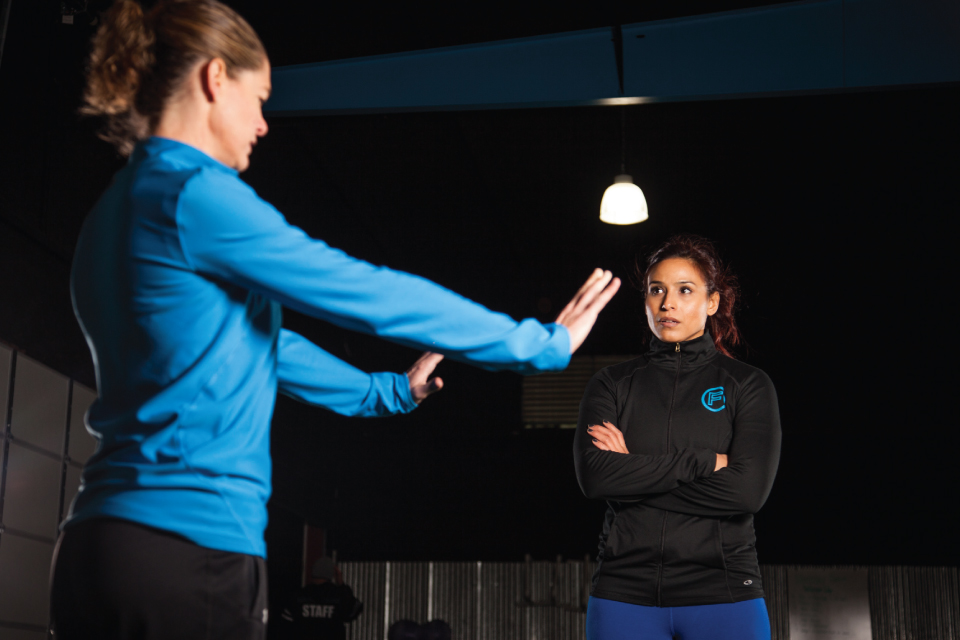
This is your year to set the bar for good. Usually at this time, people are making the choice to recommit to a fitness regime or start a whole new one entirely. One of the most important factors for being successful in exercise is making sure you master the foundational movement of an exercise. That means starting at the level of progression and load that allows you to move well and repeat the exercise through several repetitions.
Sound logical? It is, but it is also something that is often overlooked or ignored. In an attempt to “push” ourselves to lose weight and improve fitness quickly, many of us jump into an exercise without actually giving ourselves the best entry point by understanding how to adjust movements and intensity level for the exercise.
The reason that many certified trainers are so passionate about form and technique is that they know the consequences of trying to build fitness on top of poor movement. If we attempt to load an exercise when we are moving poorly and we increase the difficulty too quickly, progress is hindered or, even worse, an injury occurs. This can be extremely deflating and demotivating for someone who just arrived at the right point in his or her life to make a commitment to change. Don’t be one of those statistics; master the basic movements by creating good, clean movements as your foundation.
There are many fitness athletes and a variety of sports disciplines that work very hard to master the form and the fine details of these foundational movements. They understand that perfecting elemental movements allows them to build and layer the important challenges that shape the body and take them one step closer toward achieving a goal.
And remember: For those of you looking to lose weight in the new year, “power” is not just how explosively you can move. It's also about being able to do more work in less time. So the first step, as many professional athletes can tell you, is mastering the foundational movements.
The progression strategy:
Movement: Learn the proper form of the exercise to establish movement quality and foundational strength in order to prepare for higher levels of performance training.
Regress for Success: Use assistance or modification to reduce load and intensity while you practice proper form and control.
Progress for Challenge: Add overload variables to increase physical capacity (strength, endurance, speed, power).
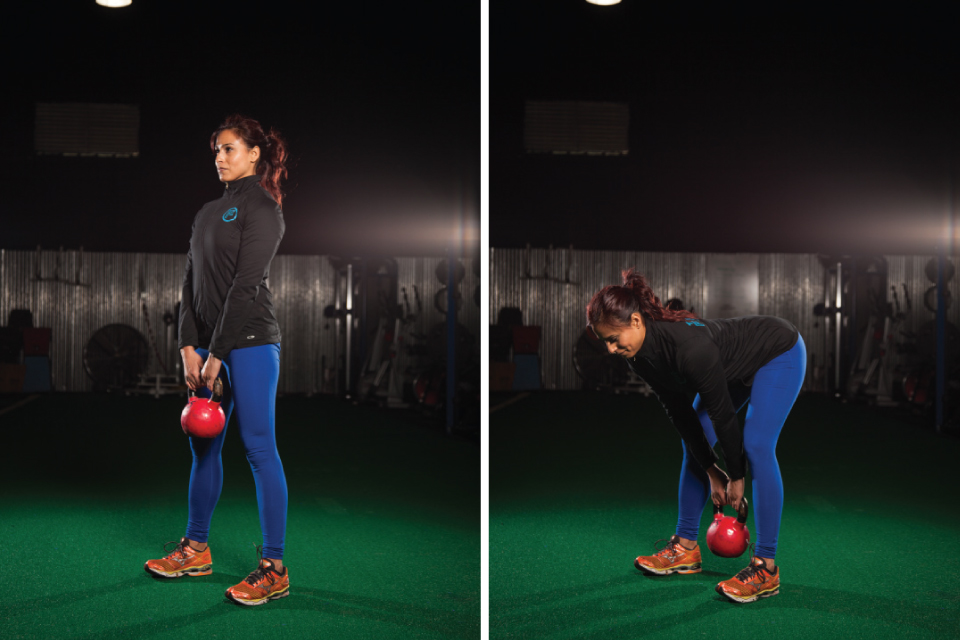
Movement: Deadlift
Purpose: This hip-dominant movement is essential to strengthening the foundational movements of the entire body as well as maintaining static and dynamic postures, and will positively affect your ability to increase your physical capacity and reach your goals.
- Stand with feet shoulder-width apart in a tall posture and with neutral spine. Place the kettlebell directly at the midpoint between your heels. Engage your lats by pulling shoulders down and back.
- Address the kettlebell by flexing at the hips and maintaining a neutral spine as the hips shift backward and the torso lowers toward the ground. As you lower the torso, reach your hands to the kettlebell, gripping it to engage core.
- Press your feet into the floor, lifting hips until the hamstrings are taut and engaged. Extend the hips fully, focusing on the hip movement to raise the torso back into an upright, tall position.
- Reverse the motion to lower the kettlebell back to the floor.
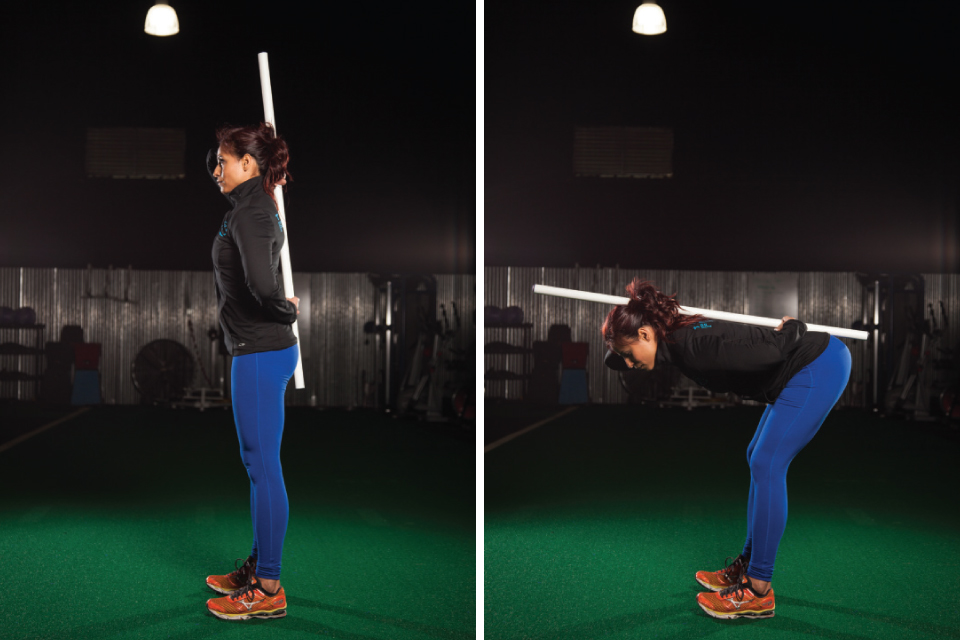
Regress for Success: Hip-Hinge Drill
- For the Hip-Hinge Drill, with feet shoulder-width apart, use a dowel or stick that will create three points of contact (at the back of the head, upper back between the shoulder blades, and the tail bone or buttocks). Hold the dowel with one hand in the curve at the back of the neck and the other in the small curve of the lower back.
- While maintaining all three points of contact, flex and reach back with the hips. Then, press through the floor with your feet, extend the hips, and return to upright posture.
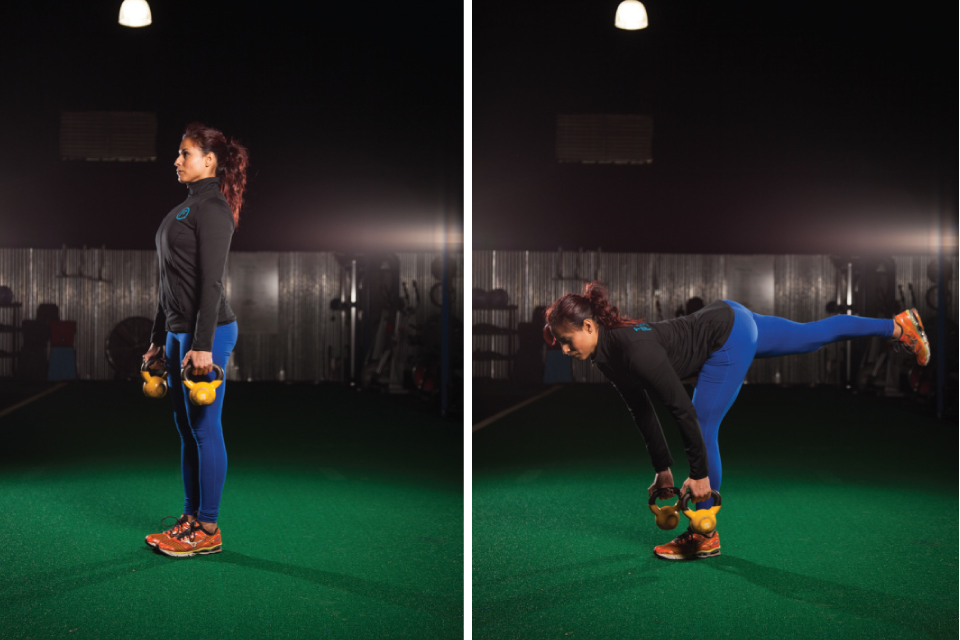
Progress for Challenge: Single-Leg Deadlift
- Using a single-leg stance, follow the instructions for the deadlift and keep the raised leg extended and reaching back with your heel on that free leg.
- There should be a straight line from your ankle, knee, and hip of the raised leg as well as the torso and head at all times during the downward and upward movement of the deadlift.
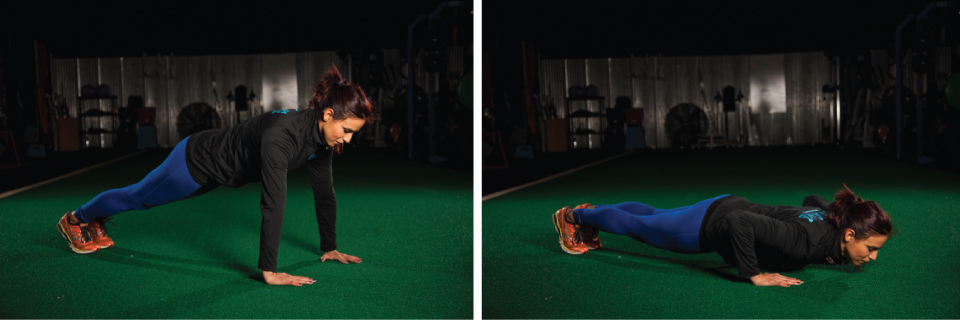
Movement: Push-Up
Purpose: This push-up movement strengthens the upper body while focusing on mastering static stability and developing strength in the torso, with hips and legs using the plank position.
- Lay on the floor with feet hip-width apart, the upper arms at 45 degrees away from your side, and hands positioned so that the thumbs are right at the crease of the armpit.
- With feet pulled toward your shins and firmly grounded, extend the legs to lift the knees from the floor and then push the torso up as one unit. This creates positive tension from feet through torso, and to the hands to ensure the core is engaged.
- When in the top position, pause on the first rep and then again occasionally throughout your repetitions to make sure that the lats are engaged and remain engaged throughout the entire movement. This creates a strong connection for stability between the arms, shoulders, and torso.
- “Pull” yourself down actively (don’t let gravity take over and get lazy on downward movement) into the lower push-up position until your upper arm is at parallel or lower to the floor. You may also use a rolled towel under the chest to ensure you reach full range of motion on each rep.
- Pause for control for one second and then push back up into top position. Repeat full movement.

Regress for Success Elevated Push-Up
- Use an elevated surface such as a box, back of a couch, or secured barbell on the rack to assist the movement and reduce the amount of body weight you are using. This also allows you to use the full plank position from head to toe to ensure your fastest progress to the full, floor push-up. (I recommend this rather than performing a push-up from your knees.)
- Make sure you maintain a strong plank position all the way through the motion and bring your chest directly toward the elevated surface.
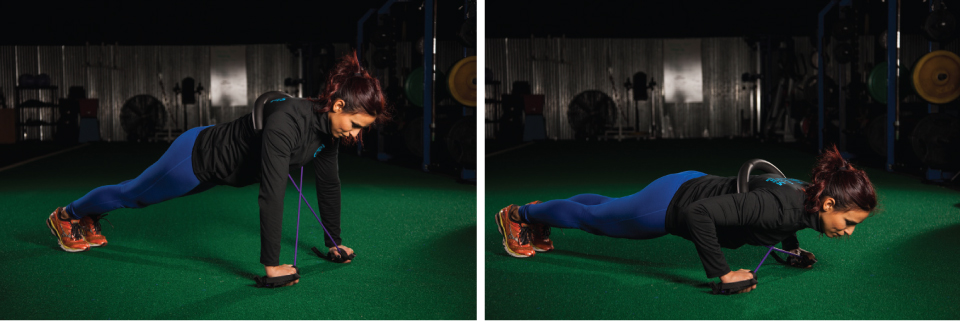
Progress for Challenge : Band-Resisted Push-Up
- Apply the variable resistance of a band to apply external resistance that is more intense in the up position, adds to eccentric loading for advanced strength development, and reduces resistance in the lower position, where some people may be more vulnerable to injury or weakness.
- Maintain a smooth, controlled pace throughout the movement and don’t let resistance increase your speed or cause you to lose control on the downward movement.

Movement: Figure 8 Drill
Purpose: This is a rotational movement focusing on the “8” pattern that connects the opposite shoulder to the opposite hip; it's a foundational movement that relates to so many physical skills such as running, throwing, and changing direction. This movement involves both rotary stability and rotation that is needed around the shoulders, hips, and thoracic spine. Many people refer to these types of movements as “core” strengthening movements.
- Start in an athletic stance, with feet facing forward and shoulder-width apart, and with neutral spine. Hold a medicine ball directly in front of the torso, using a slight bend in the elbows.
- Create one continuous movement by rotating the right shoulder down toward the left hip and reaching just outside the shoulders with the ball. Then, sweep the ball upward on that side to the top of the left shoulder and rotate down toward the right hip. Sweep the ball back up to the top of the right shoulder. Follow this figure 8 pattern using a continuous flow and count each time the ball crosses the center in front of the torso.
- Create a full range of motion and allow the hips to fully turn by releasing the heel of the trailing foot to the direction that you are moving.
- Once you achieve the movement for the desired number of repetitions, reverse the direction of movement while maintaining the same figure 8 pattern.

Regress for Success: Short Figure 8 Drill
- In this drill, we will reduce the intensity and focus on rotary stability of the torso. Use the athletic stance and maintain upright and neutral position during figure 8 pattern.
- Keep the ball close to the body by bending more at the elbows and shortening the lever arm for the movement.
.jpg)
Progress for Challenge: Figure 8 Skaters
- Add a low-level plyometric lateral skating movement with the lower body while performing the figure 8.
- Drive the weight of the ball to the shoe laces to create a bigger challenge and load to the muscles on the landing leg and hip as well as the muscles needed to decelerate the movement in the torso and upper body.
Be smart, and go for it. Become more skilled at the foundational movements through full ranges of motion, and the muscles will do more work and be capable of taking you farther, faster. The distance between you and feeling more fit is much shorter when you continually make progress and avoid setbacks like injury.






